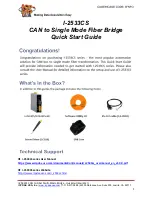
© Sealevel Systems, Inc.
- 3 -
SIO4-104.232 User Manual
Card Setup
Address Selection
The
SIO4-104.232
occupies 16 consecutive I/O locations. The DIP-switch (SW1) is used to set
the base address for these locations and the IRQ mode options. Be careful when selecting the base
address as some selections conflict with existing PC ports. The following table shows the
addressing options available. If different address options are required, please contact Sealevel
Systems Technical Support about a custom PAL option.
SW1-1 SW1-2 SW1-3 Port
1 Port
2 Port
3 Port
4
Off Off On 300 310 320 330
Off On Off 400 410 420 430
Off On On 500 510 520 530
On Off Off 600 610 620 630
On
Off
On 1500 1510 1520 1530
On
On
Off 3220 3230 3240 3250
On
On
On 4220 4230 4240 4250
Interrupt Modes
DIP-Switch positions ‘S’ and ‘M’ on switch SW1 selects the interrupt mode for each adapter.
With the ‘
S
’ selected, the adapter is in a (
S
)hared interrupt mode, which allows more than one
adapter to access a single IRQ.
‘
M
’ indicates the inclusion of a 1K-ohm pull-down resistor required on one adapter when sharing
interrupts.
Set the switch to ‘
S
’ for shared interrupt mode on all adapters sharing an IRQ. On one of the
adapters sharing an interrupt set the switches for both ‘
S
’ and for ‘
M
’. This provides the pull-
down resistor circuit that makes sharing IRQs possible. If you are using more than one
compatible adapter in a bus you should only have one adapter set to ‘
M
’.
IRQ Selection
The
SIO4-104.232
has an interrupt selection jumper, which should be set prior to use, if an
interrupt is required by your application software. Consult the user manual for the application
software being used to determine the proper setting.
Clock Modes
The
SIO4-104.232
utilizes a 14.7456 MHz oscillator. This is eight times faster than the standard
COM: port oscillator, which typically is 1.8432 MHz. This allows the adapter to achieve a
maximum data rate of 921.6Kbps. The following sections outline the baud rate calculations and
instructions for achieving your desired baud rate.
Baud Rates and Oscillator value
The following table shows some common data rates and the rates you should choose to achieve
them when using the
SIO4-104.232
. If the O/S of choice is Windows 95/98/ME/2000/NT/XP,
the oscillator value (14.7456 MHz) should be entered into the ‘Advanced Tab’ on
95/98/Me/2000/XP Device Manager applet. Typically this is done automatically when the
Sealevel Software driver is loaded.




































